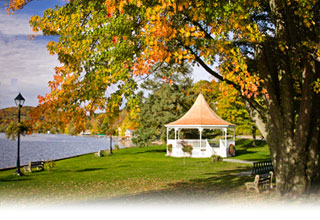The Origins of North Hatley
Just like its stunning landscape and beautiful heritage homes, North Hatley’s history deserves to be discovered!
The land that we stand on is the unceded ancestral territory of the Wabanaki Nation (Abenaki), the Ndakina.
At the Heart of the Site, a Lake
In 1792, Captain Ebenezer Hovey, an American from Connecticut “discovered” Lake Massawippi. He was no doubt impressed by the serene lake and surrounding mountains: Together, they form a unique complex that makes this site one of the most beautiful in the Province.
Just like Magog, Memphrémagog, Coaticook, and Megantic, “Massawippi” stems from an Abenaki word meaning “abundance of clear water” (Source). The lake, whose shape is reminiscent of that of a seahorse, measures 15 km²; its greatest depth is 75 m.
First Arrivals
Loyalists from south of the nearby border, fleeing the American Revolution, were attracted to the area by the view of the lake and the mountains, the microclimate and the dense vegetation, not to mention abundant fish and game. The new inhabitants chose to call the region “Hatley”, after an English village.
In 1803, the Hatley Township was granted to Ebenezer Hovey and to Henry Cull, an English businessman, and their associates.
In 1830, the land that made up Massawippi Outlet, as it was then called, essentially belonged to three families – the Culls, the Wadleighs and the LeBarons – whose descendants still live in the area.
With the opening of the first post office around 1859, Massawippi Outlet took on the name of North Hatley.
The first source of income was potash (as evidenced by the nearby Capelton mines), and a number of trades eventually contributed to the prosperity of the region: butter factories, flour mills, blacksmith shops, butchers, farmers, etc.
The Railway
Yet if it hadn’t been for the railway, the little community would have remained a well-kept secret for a long time.
In 1852, however, the St. Lawrence & Atlantic Railroad built the Eastern Townships’ very first railway line, linking Longueuil, on the south shore of Montreal, to Sherbrooke.
The goal was to connect Montreal to an ocean port in order to avoid interrupting transatlantic shipping during the cold season, when the St. Lawrence wasn’t navigable.
As soon as 1853, the line was extended to Portland, Maine, passing through North Hatley.
By 1869, North Hatley boasted a post office, a general store and a few houses. Five years later, the small village underwent a building boom: several houses and a railway station were built, and the 1881 edition of the Atlas of the Eastern Townships shows a hotel, a church, a blacksmith shop and several farms.
Southern Summer Vacationers
Around 1886, a seemingly innocuous event was to change the destiny of the small village quietly nestled at the tip of the lake: Dr. Powhatan Clark and his family, from Baltimore – who were guests of Wilford LeBaron – were delighted by the view of lake and the surrounding countryside.
Succumbing to the charm of the site, they decided to have a secondary residence built and spend their summers in North Hatley.
They were soon to be followed by the Brents, the Daves, the Browns, the Carringtons, and many others who could afford, summer after summer, to migrate – often in private railway cars – to this haven of beauty and freshness, away from Maryland’s sweltering heat.
This great migration of American tourists from the South to North Hatley was made possible by the inauguration of the Massawippi Valley Railway, which connected Newport, Vermont, to Lennoxville.
Undoubtedly, the habits of the locals were somewhat disrupted by the arrival of these vacationers from the South, who arrived accompanied by their black servants.
“It is said that when crossing the Northern States they would lower the blinds on the cars! An elderly Sherbrooke resident reminisced about the fascination that each highly animated train arrival exerted on the population at the onset of summer. ‘You would see families of Southerners arrive with black servants and mountains of luggage!’” (Hélène Laberge, L’Agora).
Besides building imposing villas on the Lake and mountainsides, these part-time residents also brought some of their culture with them, hiring, for example, prominent New York architect Bertram Goodhue to design the St. Barnabas Church (1894).
This is not to say that the American families were the only ones who took advantage of North Hatley summe: the village was also very popular with affluent families from Montreal.
A Distinguishing Feature
The village was incorporated as a municipality in 1887, and services and activities were soon deployed to fill the recreational needs of the seasonal residents.
The Massawippi Canoe Club was created in 1883 and the North Hatley Club (tennis, canoeing, sailing, swimming, and social activities) in 1897; the library followed in 1898, and a year later a golf course appeared on the hills overlooking the eastern side of the Lake.
Several luxury hotels were established and steamboats took well-to-do vacationers on trendy “mini-cruises” around the lake.
In 1897, North Hatley acquired town status. In 1903, the Goad Atlas recorded the winter population of North Hatley at 250 and the summer population at 1200, clearly illustrating the importance of summer vacationing to the life of the village.
On Main Street, at the heart of the village, one could find a railway station, several shops, three churches, and a post office. Although farming persisted on River Road and Sherbrooke Road, North Hatley was essentially an affluent holiday village.
This trait was to become even more prevalent over the following decades, and is clearly still present today!
Main Sources and Links of Interest
- Urbanism Report by Pierre Landry, sponsored by the Village of North Hatley, 1986
- North Hatley: cent ans d’histoire, by Hélène Laberge
- Register of Canada’s Historic Places
- Site du patrimoine de North Hatley (North Hatley in the Quebec Heritage Register)
- View of the train station in 1910
- View of the lake, engraving, c. 1842
